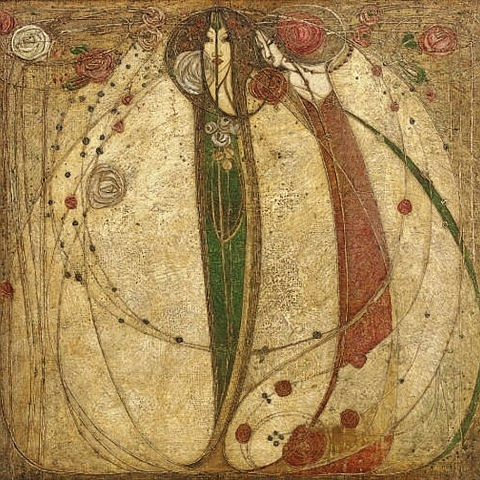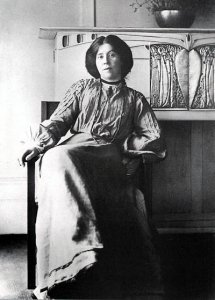Margaret Macdonald Mackintosh (1864-1933).
- Profession: Designer.
- Residences:
- Relation to Mahler:
- Correspondence with Mahler:
- Born: 05-11-1864 Tipton, England.
- Died: 07-01-1933 London, Chelsea, England.
- Buried: Unknown.
Margaret Macdonald Mackintosh was a Scottish artist whose design work became one of the defining features of the “Glasgow Style” during the 1890s. Born Margaret Macdonald, at Tipton, near Wolverhampton, her father was a colliery manager and engineer. Margaret and her younger sister Frances both attended the Orme Girls’ School, Newcastle-under-Lyme, Staffordshire. Their names occur in the school register. In the 1881 census Margaret, aged 16, was said to be a scholar. She was a visitor at someone else’s house on census night. By 1890 the family had settled in Glasgow and Margaret and her sister, Frances Macdonald, enrolled as students at the Glasgow School of Art. There she worked in a variety of media, including metalwork, embroidery, and textiles.
She was first a collaborator with her sister, Frances, and in the 1890s the pair opened the MacDonald Sisters Studio at 128 Hope Street, Glasgow. Their innovative work was inspired by Celtic imagery, literature, symbolism, and folklore. She later collaborated with her husband, the architect and designer Charles Rennie Mackintosh (1868-1928). They married on August 22, 1900. Her most dynamic works are large gesso panels made for the interiors that she designed with Mackintosh, such as tearooms and private residences.
Charles Rennie Mackintosh is commonly recognized as Scotland’s most famous architect, while Margaret is traditionally depicted as his supportive spouse. Yet Mackintosh has admitted that much of his success and creativity is in fact to be attributed to the influence of his wife, who he referred to as a “genius.”
Together with her husband, her sister, and Herbert MacNair, she was one of the most influential members of the loose collective of the Glasgow School known as “The Four”. She exhibited with Mackintosh at the 1900 Vienna Secession, where she was arguably an influence on the Secessionists Gustav Klimt and Josef Hoffmann.
Macdonald was celebrated in her time by many of her peers, including her husband who once wrote in a letter to Margaret “Remember, you are half if not three-quarters in all my architectural work …”; and reportedly “Margaret has genius, I have only talent.” It is not known exactly which of Charles Rennie Mackintosh’s works Margaret was involved with (or the extent to which she worked on them) but she is credited with being an important part of her husband’s figurative, symbolic interior designs. Many of these were executed at the early part of the twentieth century; and include the Rose Boudoir at the International Exhibition at Turin in 1903, the designs for House for an Art Lover in 1900, and the Willow Tea Rooms in 1902. Active and recognized during her career, between 1895 and 1924 she contributed to more than 40 European and American exhibitions. Poor health cut short Margaret’s career and, as far as is known, she produced no work after 1921. She died in 1933, five years after her husband.
Her best-known works include the gesso panel The May Queen, which was made to partner Mackintosh’s panel The Wassail for Miss Cranston’s Ingram Street Tearooms, and Oh ye, all ye that walk in Willowood, which formed part of the decorative scheme for the Room de Luxe in the Willow Tearooms. All three of these are now on display in the Kelvingrove Museum in Glasgow. In 2008 her 1902 work The Red Rose and the White Rose was auctioned for 1.7 million UK pounds or $3.3 million.

Margaret Macdonald Mackintosh (1864-1933), White Rose And Red Rose, 1902.

